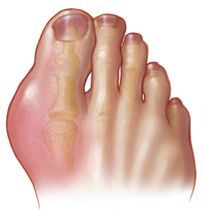 Gout’s Resurgence Author: Lindsay Getz The increase in the number of people experiencing gout creates good reason to become educated on this troublesome disease. While many people have heard of gout, the idea that it’s a ‘disease of the past’ has made it one of those ailments about which most know very little. But older adults who suffer from this excruciating form of inflammatory arthritis know it’s a condition that warrants attention. In fact, gout has made a massive resurgence, and some studies even suggest the number of cases in this country has doubled in the last three decades. Once called the disease of kings because of its association with living the high life, gout, as doctors know, can strike anyone, though it’s thee to four times as common in men as in women. And there are certainly factors that put some at higher risk than others. While we know that it’s not just a rich man’s disease, it’s easy to understand the origin of this former belief. Modern research has demonstrated that overconsumption of luxury foods such as red meat, shellfish, hard liquor and beer may increase the risk of a gout attack. The reason is that these foods are rich in purines, chemical components that eventually become uric acid and, in cases of excess, can metabolise into crystal that settle into the joints and cause great pain. In addition to being linked with eating purine-rich foods, gout is also associated with obesity in general, as well as with conditions such as diabetes, hypertension and heart disease – all of which seem to be on the rise globally. There’s even been studies that show a high incidence of people who drink sugary beverages. A study found men who consume at least two soft drinks per day had an 85 percent greater likelihood of developing gout than those who drank less than one per month. In fact, even at lower levels, soda consumption increased the risk of gout in study participants. Another potential cause of gout is kidney malfunction, which can result in a build up of uric acid. And, like most diseases, there can be a genetic component. In fact one in four gout sufferers have a family history of it. Gout, may in fact, be entirely hereditary, so it’s important that those with a family history of gout go out of their way to avoid foods that are high in purines and live a healthy lifestyle. While genetics have left some people predisposed to developing the disease, the resurgence of gout is likely linked to the way westerners live today. There is a lot of speculation that the rising number of gout cases may correlate with the obesity epidemic. It also happens to be a disease that affects older adults. Because it occurs in the ageing population, as more New Zealanders get older, it makes sense we're seeing more cases surface. 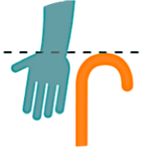 When gout strikes Gout is most commonly known for causing sudden pain and swelling in the big toe. While that’s not the only place it can strike, about 90 percent of gout sufferers will at some point experience such pain and swelling in the big toe. Gout can actually affect a number of joints, including the knees, elbows, wrists and those of the hands and feet. Symptoms include swelling and redness around the affected joint, sudden and severe pain, limited movement in the affected joint, and in some cases, a fever. In addition, as the crystals accumulate with joints, they can form tophi or chalk like lumps and bumps that can actually become deforming over time. Once the gout attack subsides, it’s also possible the skin around the joint to peel. An initial gout attack may last anywhere from three to 10 days. While it may not always be possible to prevent gout, especially when it’s hereditary, there are ways to decrease the likelihood of an attack. According to Naomi Schlesinger, MD, chief of the division of rheumatology at the University of Medicine and Dentistry of New Jersey, losing weight or maintaining a healthy weight, eating a diet low in purine-rich foods and fructose and treating underlying conditions such as hypertension and diabetes are effective preventative measures. The emergence of a gout attack has also been associated with cold temperatures. This may be one reason why it occurs in the joints of the big toe, which are the farthest away from the centre of the body. Classically, an attack of gout comes on at night. Gout sufferers often describe episodes of waking up in the middle of the night with cold feet and a tremendous amount of pain in the big toe. It’s not proven as an effective preventative measure, but it can’t hurt to try and keep your feet warm during the night, perhaps sleeping with a pair of socks on. Keeping gout at bay Besides making lifestyle changes to control gout, certain medications can ease the pain and help prevent future attacks. Nonsteroidal anti-inflammatory drugs, colchicine and steroids, have all long been used for gout treatment. However the rapid reappearance of this disease has prompted many drug companies to scramble to improve on old treatments with stronger and more effective drugs. As researchers continue to make advances toward better gout treatment, one of the most important roles that professionals can take for their patients is that of an educator. Since gout is not a disease of the past and is actually a very real modern-day concern, it will help to empower patients with vital information. But first, it’s imperative to be self-educated. It’s important that individuals in positions to recognise the symptoms of gout, including those in various facets of the medical field, in social work positions, or involved with geriatric care, become more familiar with the disease. Education is definitely important in making the right diagnosis and knowing the different treatment options available today. Becoming educated can help carers better care for their patients by recognising the symptoms early and helping prevent future attacks. The prevention of gout dovetails nicely with the prevention of many other chronic medical problems that are known to affect the ageing population – obesity, cardiovascular disease, and diabetes, in particular. It really comes down to weight control, balanced diet and activity levels; these are three areas that should already be focused on to prevent other medical conditions in older adults. It’s interesting that the rise of gout has paralleled the risk of these other chronic diseases within our society and it’s easy to link them all to being inactive, overweight and making bad food choices. It’s important for people to recognise that a lot of these chronic medical conditions really have the same common genesis and require making the same lifestyle changes for better health. Author: Lindsay Getz Aged Care Issue 2 2021 If you need help to reduce purine in your diet
our friendly Dietitians can help just contact Therapy Professionals Ltd Ph: 03 377 5280 Email: [email protected] Exercise as Therapy The not-so-surprising potential of exercise for treating people with multiple chronic conditions Authors: Alessio Bricca, Postdoc, University of Southern Denmark Søren T. Skou, Professor, University of Southern Denmark 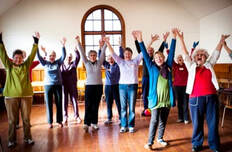 Hundreds of millions of people of all ages worldwide live with two or more chronic conditions – commonly defined as multimorbidity. Those living with it are found to have poorer physical and mental health, a high risk of being admitted to hospital and a higher risk of dying prematurely compared to people with only one chronic condition. Given that the number of people living with multimorbidity is only expected to rise in the future, finding better treatments is considered the next major health priority. But despite multimorbidity being a leading cause of disability, research on treatments is still in its relative infancy. Few studies have investigated the long-term treatment options – and unfortunately the results of the studies done most often offer negligible improvements. People with multimorbidity require treatments that will improve their physical, mental, emotional and social heath, and of late more and more research is showing that exercise may actually be a broad-spectrum treatment for those living with multimorbidity and offer many of the improvements patients want. Currently, multi-morbidity is managed by treating each chronic condition separately using available medicines. However, this approach may not reduce symptoms sufficiently, and can have additional adverse health effects. As many people consult several health care providers, and also end up taking multiple drugs (often at least one for each condition) there is a risk of adverse events that can be inconvenient and unsatisfactory for patients. Exercise as medicine Research has shown that exercise is an effective treatment for more than 26 chronic conditions, including psychiatric diseases such as depression, anxiety, stress and schizophrenia; neurological diseases including dementia, Parkinson’s disease, multiple sclerosis; metabolic diseases including adiposity, hyperlipidaemia, metabolic syndrome, polycystic ovarian syndrome, type 1 and 2 diabetes; cardiovascular diseases including hypertension, coronary heart disease, heart failure, cerebral apoplexy, and intermittent claudication; pulmonary disease including chronic obstructive pulmonary disease, asthma, cystic fibrosis; musculoskeletal disorders including osteoarthritis, osteoporosis, back pain, rheumatoid arthritis; and cancer. Research also shows exercise could potentially prevent at least 35 chronic conditions from developing. Thanks to the overall effects on health such as lowering blood pressure, improving joint health and cognitive function, exercise therapy can benefit a range of chronic conditions. It also has a lower risk of negative side effects compared to pharmalogical treatments. What should be noted, however, is that exercise requires physical effort, and like pharmalogical treatments, the effects will diminish if the patient stops partaking. The real question, could exercise therapy benefit people with multiple chronic conditions as well? A recent review assessed the effect of exercise therapy on the physical and mental health of people with at least two of the following chronic conditions: osteoarthritis of the knee or hip, hypertension, type 2 diabetes, depression, heart failure ischemic heart disease and chronic obstructive pulmonary disease. The review established 23 studies that looked at adults 50 to 80 years of age. The exercise therapy interventions used in the studies were at least partially supervised by a physiotherapist or an exercise physiologist. Most lasted 12 weeks on average and exercise was performed two to three times week, starting from low intensity and progressing to moderate to high intensity. The exercise therapies included were aquatic exercise, strength training, aerobic training and tai chi. The review results showed unequivocally that exercise therapy improved quality of life, and reduced anxiety and depression symptoms. The benefits were higher in younger patients and patients who had higher depression symptoms before starting exercise therapy. This highlights that people with severe depression - often considered ineligible for exercise due to their depression severity – may benefit highly from exercise therapy. Patients who participated in exercise therapy were also able to walk longer. Those taking part walked on average 43 metres more over six minutes than those not taking part in the exercise interventions. This improvement appeared to be important for the patient and it reduced their disability to a noticeable level. Exercise therapy also didn’t increase the risk of non-serious side effects, such as knee, arm or back pain, or falls and fatigue. What’s more, it reduced the risk of hospitalisation, pneumonia and extreme fatigue. The benefits were similar across all the combinations of chronic conditions included in the study, effectively concluding that exercise could be a safe and effective therapy instead of increasing drug prescription in people with multiple chronic conditions. Together with patients and healthcare professionals, many aged care facilities have or are developing and testing exercise therapy and self management programmes to help carers understand whether personalised exercise therapy and self management is effective in managing and treating multi morbidity conditions in their patients. In the meantime, people with multi morbidity can improve mental and physical health by exercising two to three times a week. Aerobic workouts, strength training or a combination of the two can promote similar health benefits regardless of the conditions a person lives with. Authors: Alessio Bricca, Postdoc, University of Southern Denmark Søren T. Skou, Professor, University of Southern Denmark From Aged Care NZ Issue 02 2021 If you need help to increase your exercise or to ensure the exercise you do is safe for you our friendly physiotherapists can help. Just contact Therapy Professionals on Phone: 03 377 5280. Email: [email protected] World Arthritis Day - 12 October 2021 Nutrition Tips for People with Arthritis  Good nutrition can be helpful in:
Omega 3 Oils There is limited evidence that fish oils (omega 3) reduce inflammation in some people with arthritis. Omega 3 oil is also thought to reduce risk of heart disease. It is recommended to have 1-2 servings of fish or other seafood a week for good health. Omega oil is also found in flaxseed oil, walnuts and a small amount in red meats. Vitamin Supplements If you are unable to achieve a healthy food intake, vitamin supplements maybe necessary. Talk with your Doctor about this. Alternative arthritis treatments Alternative treatments are available for many chronic diseases. Discuss these with your Doctor before you try them as they may interact with your treatment.  Need more help? Therapy Professionals Ltd has experienced Dietitians who can provide group or individual nutrition education. For enquiries: Phone 377 5280. Email: [email protected]  Calcium
Ways to Maintain Healthy Weight To lose weight Even a small reduction in body weight will relieve stress on joints
Ways to gain weight For some people, keeping weight on can be a struggle
If you would like advice from our Dietitians, call us, we come to you
Therapy Professionals Ltd Phone No: (03) 377 5280 Email: [email protected] Website: www.therapyprofessionals.co.nz What is Cerebral Palsy? Cerebral Palsy (CP) is the leading cause of physical disability in New Zealand children. It is an umbrella term for a group of lifelong conditions affecting a person’s movement, which is caused by damage to the area of the brain that controls muscle tone. It may affect muscle:
Cerebral Palsy occurs during pregnancy, at birth or shortly after, in 80% of cases the cause is unknown. There are risk factors for cerebral palsy. they may include:
Cerebral palsy affects people in different ways, ranging from, a mild form where a limb may be slightly affected and barely noticeable, to a severe form where the whole body is affected andmay be accompanied by visual, learning, hearing, speech, epilepsy and intellectual impairments. There are four types of cerebral palsy – spastic, athetoid, ataxic and mixed Spastic Cerebral Palsy - This is most common affecting 70% -80% of those with cerebral palsy. The muscles become stiff and tight making movement difficult. There are five sub categories based on the limbs affected:
Athetoid Cerebral Palsy – affects about 10-20% of those with cerebral palsy. It is characterised by uncontrolled, purposeless, slow, writhing movements where the muscles change from being tense to being floppy. It commonly affects the arms, legs, feet and hands and sometimes the face and tongue. This movement often increases under stress and stops while sleeping Ataxic Cerebral Palsy – affects about 5-10% of those with cerebral palsy. It is characterised by low muscle tone and poor coordination. It affects balance and depth perception giving a wide gait and making the person look unsteady and shaky on their feet or when handling objects. Mixed Cerebral Palsy - affects 10% of those with cerebral palsy and involves several areas of the brain and the symptoms will be a mix of the other three types of cerebral palsy described above. There is no known cure for cerebral palsy and some symptoms may improve or worsen with time. Treatment can help manage the condition, there are a number of different approaches to treatment: 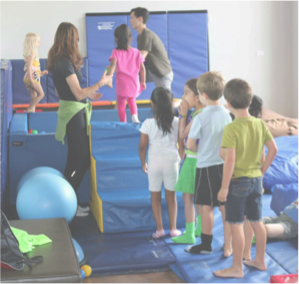 Treatments Botox - An injection of botulinum toxin is effective for reducing over-activity in muscles. This results in a reduction in muscle strength and muscle tone with small, short-lived gains in aspects of gait and function. Conductive Education – is based on the brain's ability to re-wire itself and teaches children with cerebral palsy to coordinate their movements. Cranial Osteopathy – there is limited evidence that cranial osteopathy help Cerebral Palsy Occupational Therapy - can help with muscle and joint coordination issues that make everyday tasks difficult including eating, brushing teeth and bathing. Can help to improve physical, cognitive, social abilities, fine motor skills, posture and sensory processing Physiotherapy – for children with cerebral palsy is to increase mobility while promoting physical development like sitting, crawling, and walking. With regular physiotherapy treatment, and equipment the physiotherapy goals include: Improved muscular strength and activation
Physiotherapy for an adult’s cerebral palsy includes:
Bobath a physiotherapy method - promotes motor learning for efficient motor control in various environments, thereby improving participation and function. Speech Language Therapy - improve a child’s speech and communication by strengthening the muscles used for speech, increasing oral motor skills and by improving their understanding of speech and language. It also can help with swallowing disorders, like dysphagia. Surgical interventions - Orthopaedic surgery addresses several different areas: gait abnormalities, correction of hip deformity, upper limb and scoliosis surgery. Short muscles cannot be lengthened but surgery can alter the length of the tendons, redirect the tendons and, in some cases, divide the tendons to remove an abnormal force. Lengthening tendons reduces tension in the muscle in the short term. If you know someone who is struggling with cerebral palsy our friendly therapists may be able to help, just contact us at Therapy Professionals Ph: 03 3775280 Email: [email protected] |
AuthorShonagh O'Hagan Archives
July 2024
|

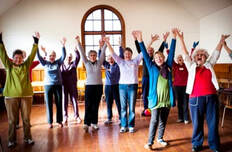
 RSS Feed
RSS Feed